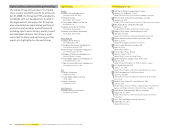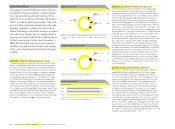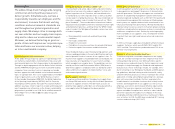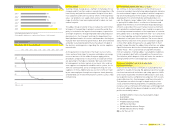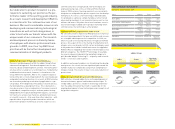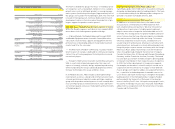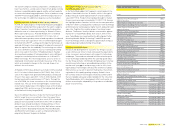Reebok 2008 Annual Report Download - page 71
Download and view the complete annual report
Please find page 71 of the 2008 Reebok annual report below. You can navigate through the pages in the report by either clicking on the pages listed below, or by using the keyword search tool below to find specific information within the annual report.
adidas Group Annual Report 2008 067
Sustainability
The adidas Group must manage wide-ranging
commercial and competitive pressures to
deliver growth. Simultaneously, we have a
responsibility towards our employees and the
environment, to ensure that decent working
conditions and environmental standards are
met throughout our global organisation and
supply chain. We always strive to manage both
our own activities and our supply chain respon-
sibly and to reduce our environmental impact.
Moreover, we believe that acting as good cor-
porate citizens will improve our corporate repu-
tation and hence our economic value, helping
us to be a sustainable company.
Active engagement with stakeholders
At the adidas Group, we pursue a policy of open dialogue with
our numerous stakeholders, involving them in key social and
environ mental decisions that shape our day-to-day operations.
Through in-depth engagement with the Better Cotton Initiative
and the AFIRM Working Group, we work closely with leading
companies from a variety of sectors to develop sustainable
business approaches and to debate social and environmental
topics on a global level. This is also supported by our member-
ship in organisations such as the World Business Council
for Sustainable Development (WBCSD), the World Federation
of the Sporting Goods Industry (WFSGI), the Fair Factories
Clearinghouse (FFC) and the Fair Labor Association (FLA). In
addition, we always strive to report in an open and transparent
way. Comprehensive information on the Group’s sustainability
programme is provided in our 2008 Social and Environmental
Online Report on our website www. adidas-Group.com /
sustainability.
Workplace Standards set rules in supply chain
Covering health and safety, labour rights and environmental
protection at our own sites and our suppliers’ factories is of
highest importance to us. Therefore, we have defi ned rules
or standards by our own corporate values as well as by what
society expects of global businesses. We have condensed our
rules into a supplier code of conduct that we call our “Work-
place Standards”. These are based on International Labour
Organization (ILO) and UN conventions relating to human rights
and employment practices, and they follow the WFSGI model
code of conduct. Our Workplace Standards contain clear rules
of conduct regarding:
—
Environmentally sound, safe and healthy working
conditions
—
Fair wages and benefi ts
—
Freedom of association
—
Prohibition of excessive overtime, forced and child labour
—
Protection against harassment and discrimination
These Standards help us select manufacturing partners and
serve as guiding principles in the early identifi cation and treat-
ment of potential issues of concern at our suppliers’ sites. To
illustrate how suppliers should implement our Standards, we
have created a set of guidelines for use in factory settings,
which we update on a regular basis. The guidelines are also
used by our Social and Environmental Affairs (SEA) team to
determine suppliers’ compliance with our Standards and to
advise and train our suppliers in improving their social and
environmental performance.
Careful supplier selection
To improve working conditions throughout our supply chain,
our Group SEA team works closely with the Global Operations
function on supplier selection. The SEA team assesses all
potential new suppliers and orders can only be placed with a
new supplier when SEA approval has been granted.
Encouraging self-governance
Good management systems help factories improve their day-
to-day operations and support the process of internalisation
and self-governance. Therefore, we support our core business
partners in establishing management systems with interna-
tionally recognised standards such as ISO 14001 for quality and
environmental management. By running a certifi ed manage-
ment system, our suppliers demonstrate commitment to con-
tinuously enhancing their performance. We help them build or
improve human resources systems to maintain proper working
conditions, including factory grievance systems to routinely fi nd
and fi x non-compliance issues. Further, by enforcing employ-
ment standards at our suppliers’ sites, we empower workers
to protect their own rights and take an active role in decision-
making.
In 2008, our Group’s supply base included 20 athletic footwear
suppliers’ factories, which were OHSAS 18000 and /or ISO
14001 certifi ed. These factories produced around 73% of our
footwear sourcing volume.
Training to achieve sustainable compliance
To achieve long-term sustainable compliance in the supply
chain, we consider training even more important than moni-
toring and policing factories. Our SEA team offers specifi c
training courses and workshops for factory supervisors and
managers to help them apply our Standards and implement
best practices. These workshops include, for example, intro-
ductory training on our Workplace Standards and SEA operat-
ing guidelines, detailed training on effective health, safety
and environmental practices as well as training in the correct
application of rating and compliance planning tools and sup-
plier self-assessment methods. Further, we promote the
establishment of sustainable structures that actively involve
workers and management of our suppliers as well as local
employee associations and non-governmental organisations
(NGOs). The team also organises workshops for licensees,
agents and adidas Group business entities in order to build
personnel capacities throughout our company. In this way,
acceptable working conditions become a routine part of busi-
ness activities. In 2008, the SEA team conducted 251 training
sessions and workshops (2007: 267).







